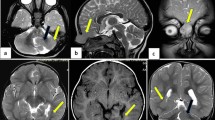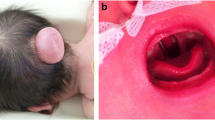Abstract
Lesions of the cerebellopontine angle (CPA) in young children are rare, with the most common being arachnoid cysts and epidermoid inclusion cysts. The authors report a case of an encephalocele containing heterotopic cerebellar tissue arising from the right middle cerebellar peduncle and filling the right internal acoustic canal in a 2-year-old female patient. Her initial presentation included a focal left 6th nerve palsy. Magnetic resonance imaging was suggestive of a high-grade tumor of the right CPA. The lesion was removed via a retrosigmoid approach, and histopathologic analysis revealed heterotopic atrophic cerebellar tissue. This report is the first description of a heterotopic cerebellar encephalocele within the CPA and temporal skull base of a pediatric patient.



Similar content being viewed by others
Change history
04 November 2021
A Correction to this paper has been published: https://doi.org/10.1007/s00381-021-05396-1
References
Calzada AP, Go JL, Tschirhart DL, Brackmann DE, Schwartz MS (2015) Cerebellopontine angle and intracanalicular masses mimicking vestibular schwannomas. Otol Neurotol 36:491–497
Doherty J, Go JL, Linthicum FH Jr (2014) Neurofibromatosis 2 invasion of the internal auditory canal wall: clinical significance. Otol Neurotol 35:1662–1668
Gao K, Ma H, Cui Y, Chen X, Ma J, Dai J (2015) Meningiomas of the cerebellopontine angle: radiological differences in tumors with internal auditory canal involvement and their influence on surgical outcome. PLoS One 10:e0122949
Larner AJ (2003) False localising signs. J Neurol Neurosurg Psychiatry 74:415–418
Ginn KF, Gajjar A (2012) Atypical teratoid rhabdoid tumor: current therapy and future directions. Front Oncol 2:114
Biswas A, Kashyap L, Kakkar A, Sarkar C, Julka PK (2016) Atypical teratoid/rhabdoid tumors: challenges and search for solutions. Cancer Manag Res 8:115–125
Lee IH, Yoo SY, Kim JH, Eo H, Kim OH, Kim IO, Cheon JE, Jung AY, Yoon BJ (2009) Atypical teratoid/rhabdoid tumors of the central nervous system: imaging and clinical findings in 16 children. Clin Radiol 64:256–264
Peris-Celda M, Giannini C, Diehn FE, Eckel LJ, Neff BA, Van Gompel JJ (2018) Glioneuronal heterotopia presenting as cerebellopontine angle tumor of cranial nerve VIII. World Neurosurg 114:289–292
Ferland RJ, Batiz LF, Neal J, Lian G, Bundock E, Lu J, Hsiao YC, Diamond R, Mei D, Banham AH, Brown PJ, Vanderburg CR, Joseph J, Hecht JL, Folkerth R, Guerrini R, Walsh CA, Rodriguez EM, Sheen VL (2009) Disruption of neural progenitors along the ventricular and subventricular zones in periventricular heterotopia. Hum Mol Genet 18:497–516
Matyja E, Grajkowska W, Marchel A, Rysz A, Majkowska-Zwolinska B (2007) Ectopic cerebellum in anterior cranial fossa: report of a unique case associated with skull congenital malformations and epilepsy. Am J Surg Pathol 31:322–325
Muzumdar D, Michaud J, Ventureyra EC (2006) Anterior cranial base glioneuronal heterotopia. Childs Nerv Syst 22:227–233
Gunbey HP, Bilgici MC, Aslan K, Aygun C, Celik H (2016) Ectopic cerebellar tissue of the posterior cranial fossa: diffusion tensor tractography and MR spectroscopy findings. Childs Nerv Syst 32:195–198
Acknowledgments
We thank Arie Perry, MD, at the University of California, San Francisco, for assistance with pathological analysis in this case and Kristin Kraus, MSc, for editorial assistance.
Author information
Authors and Affiliations
Corresponding author
Ethics declarations
Conflict of interest
None.
Consent
The patient’s parents consented to publication.
Additional information
Publisher’s note
Springer Nature remains neutral with regard to jurisdictional claims in published maps and institutional affiliations.
The original online version of this article was revised due to a retrospective Open Access cancellation.
Rights and permissions
About this article
Cite this article
Hamrick, F.A., Karsy, M., Bruggers, C.S. et al. Developmentally anomalous cerebellar encephalocele arising within the cerebellopontine angle and extending into the adjacent skull base in a pediatric patient. Childs Nerv Syst 37, 2943–2947 (2021). https://doi.org/10.1007/s00381-020-05020-8
Received:
Accepted:
Published:
Issue Date:
DOI: https://doi.org/10.1007/s00381-020-05020-8




